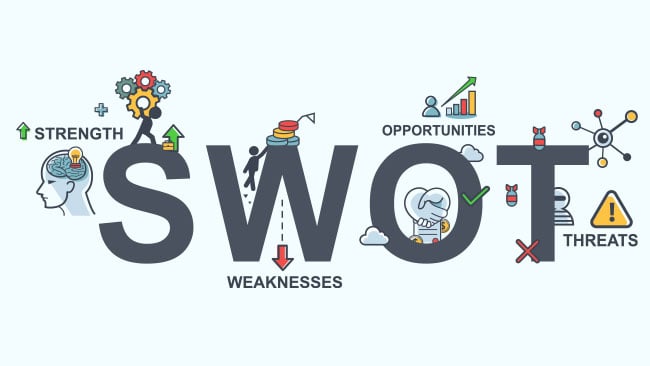If you’ve ever completed a SWOT analysis in your business — identifying the strengths, weaknesses, opportunities and threats and then never spoke of it again… then you know what I mean when I say an ‘exercise in futility.’
In this post, we’ll walk through how to take the SWOT analysis of your insurance agency and turn it into something you can use to improve organizational health, grow in profitability and develop a long-term strategic plan.

First, we want to determine what the objective of the SWOT analysis is. Generally speaking, you’re probably doing the analysis to see “how you’re doing” and of course, “what you could be doing better.” But you can get more specific and use it to answer questions such as —
How can we get to $10M in annuity production this year, for example.
If you read our last blog post, you’ve already brainstormed trends in the industry and trends you’re seeing with your competitors, which will give you a head start on the Opportunities and Threats your agency may be facing in working towards your stated objective.
The other two aspects of the SWOT analysis are where things can get difficult.
Avoid the potentially fatal flaw in the SWOT analysis
What are your strengths and weaknesses?
Well, it depends on who you ask, right? That’s what we want to try and avoid if we can — the subjectivity of the SWOT analysis.
What can help with that is to base the analysis on data. Typically, that’s not how a SWOT analysis is done, but if we want it to be more factual and actually get us somewhere, it might be a good idea to require some sort of proof around the statements being made.
And rather than make it about a certain department being a strength or a weakness, focus on areas like individual strengths and skillsets of employees based on results they’ve achieved, the business’s financial resources, the size of the business, any cost advantages, or some other competitive edge you have. For weaknesses, consider the goals that haven’t been met, the lack of resources, minimal expertise in a key area, or being short-staffed, for example.
Gather the right people for your SWOT analysis
Who are the “right” people?
It’s not just upper management or just those in a certain department.
It’s good to get people from various areas of the business (and different staff levels) involved. This helps each person feel their voice has been heard, plus each employee brings a unique viewpoint that can help in the brainstorming process.
Don’t stop at one
The SWOT analysis is only as good as the ideas you can actually come up with during the analysis.
Knowing this, it’s definitely possible that a key factor in the future success of the company could be missed, which is why it’s good to conduct SWOT analyses regularly throughout the year.
Each time you meet to check progress, ask questions like:
1. Where have we made improvements in each of the areas we identified?
2. Do we need to invest more effort in certain areas or break ground in new areas?
3. What should we consider adding to any areas?
The SWOT analysis can be a way to uncover information and to bring forth problems, but that doesn’t do much in and of itself. What you do with that information is what leads to positive changes.
As you’re working through the results of your SWOT analysis, you’ll notice there is no prioritization. The analysis won’t tell you what to focus on first, next, and last.
That’s up to you as the leader to set priorities for your team.
So, how can you use that information you’ve collected and problems you’ve identified to go a step further and develop actionable solutions and set timelines and deadlines for each?
Naturally incorporate next steps
One way is to make it a part of your overall marketing plan for the year. Which means, it’s best to conduct your first analysis as you’re creating that.
Consider your expectations for the year and compare that to the threats and weaknesses identified…
How big is that gap between the two?
Where can you map strengths to opportunities?
Think about what needs to be included in your plan to leverage strengths, minimize weaknesses, overcome threats and capitalize on opportunities. This might include training for your marketers, new tools and resources to work more efficiently, a financial consultation, guidance on entering a new line of business, or advice on how to manage a legal issue.
In the past, you might have conducted a SWOT analysis while thinking -- knowledge is power. But informed action is where the real power lies.
Want to find out how your SWOT analysis fits into a long-term strategic plan? Learn more about how we help with that here:






